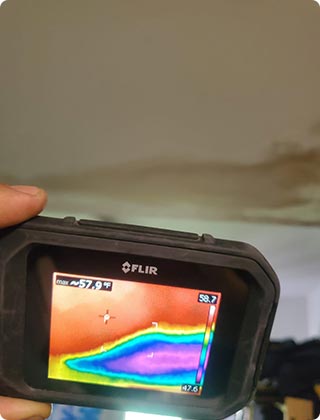MENU


Have you recently started sneezing and sniffling every few seconds, with a runny nose and a persistent rumble in your chest? Or do you constantly feel nauseated and dizzy?
Have you checked all the possible causes of these symptoms, but none of them are related to your illness? So, what could be causing these symptoms?
There is a possibility that you're constantly breathing in a thick soup of bacteria, fungi, and other microbes, plus their by-products through the means of mold spores that thrive on the moisture in your home.
If you have a problem with high levels of mold spores in your house, it's important to get rid of them as soon as possible. Besides the associated health issues, they can be highly destructive to your property.
Are you interested in learning how to get rid of mold spores in the air? In this article, we'll go over all of the ways to help you get rid of mold from your home so that you can avoid exposure. But before moving on to the solution, we need to first find out if you have a problem with mold spores in your home.
Mold is a type of microorganism that exists almost everywhere, especially if the environment is moist. It reproduces and spreads through the air by releasing tiny spores that are invisible to the naked eye. Inside your home, these spores can float through the air, causing health issues, and can also land on wet surfaces like bathroom walls, windows trim, and many others to start colonizing and result in mold growth.
Mold colonies can quickly develop if left unchecked, causing major health problems for your family and structural damage to your home.
Here are some signs that your house may have increased levels of mold spores:
If the following symptoms persist even if you have checked all possible causes, but not a single one of them applies, then there's a high chance they are caused by airborne mold spores:
If the mold has colonized your house, the affected areas may emit a damp and musty odor similar to the smell of wet socks or rotting wood. Sometimes you may notice this funky smell coming out of your air conditioner if the mold is in your vents.
If you notice any black, greenish, white or orange spots on your walls and clothes that feel slimy or puffy to touch, then this could be mold.
Mold needs moisture to thrive. If your house has obvious signs of moisture issues or water intrusion, mold will soon follow.
If your house recently flooded, then mold is likely to appear in those areas and start to reproduce and spread.
Mold outbreaks can also occur during the rainy seasons. Or they can be caused by roof leaks, appliance failures, and hidden water leaks. Remember, wherever there is excess moisture in your house, there is a high chance for mold to be there shortly after.
If you noticed any of the above signs in your house, you should hire some professionals to detect if mold spores are present. Hiring the professional mold testing service of O2 Mold Testing can give you a better idea of whether your house is contaminated with mold spores or not.
We are the best-in-town mold testing experts and we use special tools and precise lab results to figure out what type of mold is growing in your house. Our certified mold inspectors use the following methods to acquire in-depth insight into the problem and collect samples for mold diagnosis.
Mold grows in relative humidity above 60%. Our professionals use moisture meters to detect moisture pockets and pinpoint where we need to test for mold.
To detect the mold spores in the indoor air of your house, mold inspectors will take mold samples of the air. The mold Air-O-Cell cassettes are used to catch these mold spores. Then, these samples are sent to a laboratory to see if any spores are present.
A swab test is used to collect samples of mold from the suspected surface of your house. These samples are also sent to a laboratory for further analysis.
Specialists will thoroughly inspect areas of your house from all nooks and corners to the basement or attic. As they find areas that look suspicious of mold, they take samples from them and send them for further analysis.
Once the inspection is done and the type of mold is detected, the following methods are available to solve your problem:
The levels of mold spores can be reduced by using an air purifier in places where they are commonly found, like bathrooms, kitchens, and basements. These purifiers filter airborne mold spores out of the air, trapping and eliminating them, which helps to keep your home mold-free. However, this does not address the areas where mold is growing in moisture, like behind the walls or in the basement.
Dehumidifying your house can reduce the moisture level in the air and prevent mold and mildew growth. It also improves indoor air quality while providing a moisture-free environment. If you need a partial solution, dehumidifiers can help you cope with the cause of some local mold problems, but it will not clean up existing indoor mold growth.
Professionals perform comprehensive mold remediation to ensure that the whole house is free of mold. It is the most effective method to get rid of mold spores.
Each mold damage scenario is unique, requiring a customized approach and a mold cleanup that is focused on the origin of the problem. That's what remediation does. Depending on the type of mold and its location, the following are some of the steps involved in the process.
An air scrubber is the best option to clean pathogens from the indoor air. It's one of the main tools used by many professionals to assist in getting rid of mold. People might get confused about which one is better. All in all, an air scrubber is the best equipment used by every professional mold company.
The negative air machine functions similarly to the air scrubber, but the key distinction is ducting. There is no ducting on the air scrubber. As a result, most experts who use it professionally add ducting to it. Both can be used for the process as both work the same to purify the air and surface but air scrubber is used more often compared to negative air machines.
Every household needs proper maintenance to avoid any hazardous issues that can lead to health problems. If you suspect that mold is present in your house, feel free to contact O2 Mold Testing. Our expert will do an in-depth mold inspection and testing to help you and your loved ones get rid of these airborne spores. We are just one phone call away - 888-202-1680.